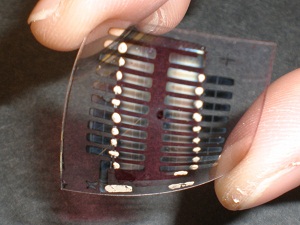A window to the future
 Building-integrated photovoltaics (PVs) are undergoing a revolution, from thin, visible PV wafers suspended in window panes to fully integrated into the windows themselves. Thanks to nanotechnology and advances in photovoltaic materials, some PV cells are now thinner than a strand of hair, and no bigger than a quarter of a grain of rice. And by replacing metals with certain hydrocarbon-based plastics, they can be made virtually invisible. This makes them ideal for a variety of applications, like turning windows into PV devices that can help power or offset a building’s energy use.
Building-integrated photovoltaics (PVs) are undergoing a revolution, from thin, visible PV wafers suspended in window panes to fully integrated into the windows themselves. Thanks to nanotechnology and advances in photovoltaic materials, some PV cells are now thinner than a strand of hair, and no bigger than a quarter of a grain of rice. And by replacing metals with certain hydrocarbon-based plastics, they can be made virtually invisible. This makes them ideal for a variety of applications, like turning windows into PV devices that can help power or offset a building’s energy use.
New Energy Technologies has developed a spray-on application that converts a window’s surface into a PV unit. The spray-on PV cells are applicable at room temperature and in normal conditions. The company said its SolarWindow units will be able to absorb light energy not only from the sun, but also from artificial light, like that produced by lights inside the office. The company was able to eliminate all metal from the cells, making them more transparent and easier to apply. New Energy is currently developing the production process to scale it up for commercial production.
Other companies are nipping at its heels. Peer Plus, a company in the Netherlands, unveiled its Smart Energy Glass, which produces electricity that powers its electrochromatic abilities—ability to shade when small amounts of electricity are applied—and also provides PV generating capabilities for use in a building. The company said it has pilot projects underway in the Netherlands, but offered no other information about its projects. In its bright mode it allows all sunlight in; in its privacy mode, the window turns opaque; and in its dark mode, it allows for additional shading.
Konarka, a producer of organic PV, made an agreement in 2009 with Arch Aluminum & Glass to integrate Konarka’s Power Plastic PV film in its windows. In November 2009, they introduced a 1.5 kilowatt PV pilot project at Arch’s office building in Tamarac, Fla.
A technology being developed at MIT uses layers of glass, each dyed a different color to collect different spectrums of sunlight at the glass’ edge. At the edge, small efficient PV cells collect the energy from each pane. The focused solar radiation increases the electrical power generated by each solar cell "by a factor of over 40," said Marc Baldo, MIT Associate Professor of Electrical Engineering.
As these new technologies make it to market, they’re likely to first find commercial applications, like windows in office buildings and high-rises. But, hopefully, homeowners can one day replace their windows with more efficient, active PV windows.



